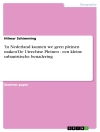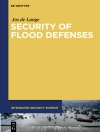Master’s Thesis from the year 2015 in the subject Urban and Regional Planning, grade: 65.00, University of Twente , language: English, abstract: Focusing on Greater Kumasi Metropolitan Area (GKMA), the fastest growing metropolitan area in Ghana, this study aims to understand the spatio-temporal dynamics of GKMA’s growth, the factors driving this process and to quantify their relative contributions. First, growth patterns during the periods 1986-2001 and 2001-2014 in were analysed. Spatial metrics were used to deepen the understanding of the patterns of growth. This revealed that of the three growth types identified in both periods, edge-expansion was predominant in both cases.
Analyses of the driving forces of GKMA’s growth was done using Spatial Logistic Regression modelling approach. A review of literature coupled with consultations with experts during fieldwork assisted in identifying locally relevant driving forces of the area’s growth. Two models were constructed on basis of the identified drivers for the periods 1986-2001 and 2001-2014. The performance of both models was evaluated and validated to identify the one that best simulates GKMA’s growth. The estimated coefficients and associated odds ratio of the models were used in assessing the individual contributions of the driving forces. The results from the analysis showed that distance to urban cluster, distance to CBD, distance to major roads and the proportion of urban cells in 7×7 neighbourhood which are common to both time periods were among the top four drivers of urban growth in both periods though with varying levels of influence. Population density was identified as the most important driver of growth during 2001-2014.
Finally, predictions of future growth were made based on the 2001-2014 model. The results of the model’s prediction mimic past trends of the area’s growth. This is because predicted growth is shown to mimic the layout of major roads as observed in reality. The study also simulated future growth based on proposed public investment on new roads so as to understand how this will influence future growth. The results from the predicted scenario showed new growth occurring which were however not associated with the updated factor. This study attributed the decline in influence of the updated factor to correlation among the variables.
Overall the results of the study shows that the integration of remote sensing, GIS, spatial metrics and logistic regression provide a powerful collection of tools for understanding the spatio-temporal dynamics of urban growth.
Abdul-Fatawu Mohammed
Spatial-statistical Modelling of Urban Growth In GKMA [PDF ebook]
Spatial-statistical Modelling of Urban Growth In GKMA [PDF ebook]
Mua cuốn sách điện tử này và nhận thêm 1 cuốn MIỄN PHÍ!
Ngôn ngữ Anh ● định dạng PDF ● Trang 86 ● ISBN 9783346449894 ● Kích thước tập tin 13.5 MB ● Nhà xuất bản GRIN Verlag ● Thành phố München ● Quốc gia DE ● Được phát hành 2021 ● Phiên bản 1 ● Có thể tải xuống 24 tháng ● Tiền tệ EUR ● TÔI 7898656 ● Sao chép bảo vệ không có












